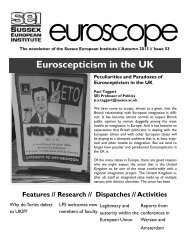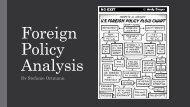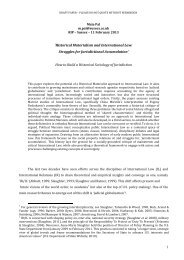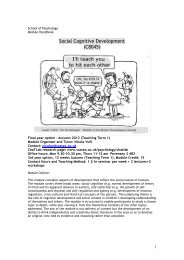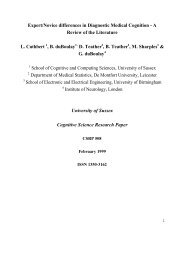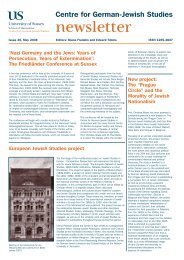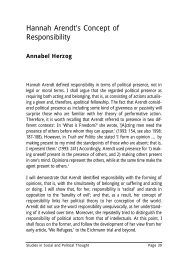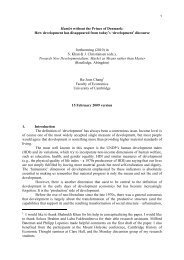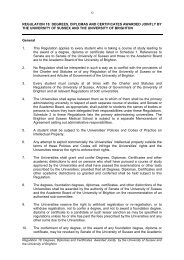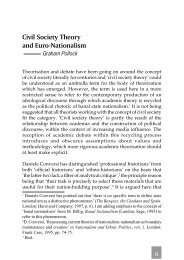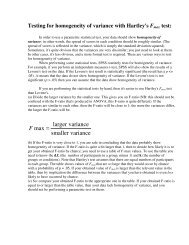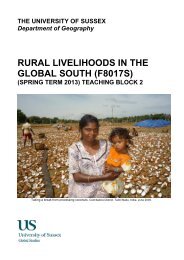'War, Peace and Feminism' [PDF 157k] - University of Sussex
'War, Peace and Feminism' [PDF 157k] - University of Sussex
'War, Peace and Feminism' [PDF 157k] - University of Sussex
Create successful ePaper yourself
Turn your PDF publications into a flip-book with our unique Google optimized e-Paper software.
War, <strong>Peace</strong> <strong>and</strong> Feminism<br />
Laura Turquet<br />
The purpose <strong>of</strong> this paper is to demonstrate two broad tendencies in International Relations, tendencies<br />
that have substantial ramifications for the theory <strong>and</strong> the practice <strong>of</strong> the discipline. The first tendency<br />
is that war is privileged over peace in the study <strong>of</strong> International Relations. This assertion must be<br />
interrogated through an analysis <strong>of</strong> the historically developed epistemology <strong>and</strong> ontology <strong>of</strong> the<br />
orthodox approach to the subject, from which I will demonstrate that war is treated as a natural state <strong>of</strong><br />
affairs in international relations, a theoretical inevitability that defines peace negatively as non-war.<br />
The outcome <strong>of</strong> this theoretical position has important consequences for the practice <strong>of</strong> international<br />
relations, i since possibilities <strong>of</strong> war as anything other than inevitable, <strong>and</strong> peace as anything other than<br />
a precarious cease-fire in the anarchic international system, are decisively foreclosed. The second<br />
tendency is that feminist accounts <strong>of</strong> war reinforce the privileged theoretical position <strong>of</strong> war over<br />
peace. This assertion requires an analysis <strong>of</strong> the various str<strong>and</strong>s <strong>of</strong> feminist writing on war <strong>and</strong> peace.<br />
There is no single feminist approach, but, I will argue, the apparent plurality <strong>of</strong> ideas clustered around<br />
the feminist theme share a failure to effectively critique the metatheoretical assumptions <strong>of</strong> the<br />
orthodox position, which results in not only the reinscription <strong>of</strong> the gender subordination that they<br />
appear to dispute, but also a continued privileging <strong>of</strong> the status <strong>of</strong> war as more ‘real’ in the world than<br />
peace. As such, the attempts <strong>of</strong> feminists to make critical interventions on the subject are limited,<br />
which in turn has implications for the possibility <strong>of</strong> imagining <strong>and</strong> creating a different world. For<br />
clarity, I will identify the two tendencies I have outlined separately, but this is not to say that they are<br />
unconnected. It is not wholly within the confines <strong>of</strong> this paper to fully explicate an alternative feminist<br />
account <strong>of</strong> war, but through critique, in the final part <strong>of</strong> the paper, I hope to indicate the ways in which<br />
feminists could reconceptualise International Relations to take account <strong>of</strong> the subordination <strong>of</strong> both<br />
gender <strong>and</strong> peace in the world, as the basis for emancipatory theory <strong>and</strong> practice.<br />
The privileging <strong>of</strong> war over peace can be observed on a day-to-day basis. How common is it to hear,<br />
‘war now seems inevitable’ or ‘the path to war is irreversible’, <strong>and</strong> how rare to hear, ‘today, peace<br />
broke out in the Middle East’ or ‘it seems that a cessation <strong>of</strong> violence is a certainty’. Whilst war is<br />
described as an uncontrollable thing that takes on a life <strong>of</strong> its own, a thing that despite best-laid plans<br />
can suddenly erupt, peace is fragile, a carefully constructed condition that seldom triumphs when the<br />
spectre <strong>of</strong> war is present. In addition, aspects <strong>of</strong> the relationship between women <strong>and</strong> war are <strong>of</strong>ten<br />
discussed: we frequently hear <strong>of</strong> the toll <strong>of</strong> apparently passive ‘women<strong>and</strong>children’ ii as victims <strong>of</strong> war,<br />
<strong>and</strong> women’s suitability for combat is questioned or their link with peace is made, as implied in<br />
George W. Bush’s recent comment on the Middle East conflict, that ‘when an 18 year-old Palestinian<br />
girl is induced to blow herself up, killing a 17 year-old Israeli girl, the future itself is dying’.<br />
It is possible to establish that the orthodox approach to the discipline <strong>of</strong> International Relations, a<br />
dominant set <strong>of</strong> theories that to a large extent inform the practice <strong>of</strong> international relations, constitutes<br />
peace within war, so that peace is conceived as the absence <strong>of</strong> war, or not-war, a relation that seriously<br />
delimits the possibilities <strong>of</strong> achieving peace in the world. In order to do this, it will be necessary for<br />
me to demonstrate a number <strong>of</strong> factors involved. Firstly, I will outline the parameters <strong>of</strong> orthodox<br />
theory, in terms <strong>of</strong> its central concepts, <strong>and</strong> more crucially, in terms <strong>of</strong> its historical development <strong>and</strong><br />
the epistemological <strong>and</strong> ontological assumptions that underpin it. Secondly, I will point to the<br />
limitations that this method <strong>of</strong> theorisation imposes on our ability to construct alternative<br />
underst<strong>and</strong>ings <strong>of</strong> the world, by examining what the orthodox view excludes. I will also establish the<br />
link between theory <strong>and</strong> practice, in order to demonstrate that the limits <strong>of</strong> what is perceived as<br />
possible in International Relations in theory delimit what is judged as realistic in practice.
2<br />
The early development <strong>of</strong> the discipline <strong>of</strong> International Relations was defined to a great extent in<br />
terms <strong>of</strong> the problem <strong>of</strong> preventing war in the aftermath <strong>of</strong> the First World War. This problem-solving<br />
approach to war meant that peace was, from the outset, defined negatively, as an absence <strong>of</strong> war. In<br />
practice, the solution to the problem was an attempt to create an international forum to promote open<br />
relations between states, to put an end to the secret diplomacy perceived to have been so divisive in<br />
Europe before 1914. The result was the foundation <strong>of</strong> the League <strong>of</strong> Nations in 1919. The ‘failure’ <strong>of</strong><br />
the League <strong>of</strong> Nations, resulting in its collapse in 1946, as well as the outbreak <strong>of</strong> war in Europe for<br />
the second time in 25 years, was constructed as the failure <strong>of</strong> so-called idealistic, Kantian<br />
cosmopolitan visions <strong>of</strong> the world, to which political realism <strong>of</strong>fered a pragmatic antidote.<br />
Realist theorists, such as Morgenthau (1985), presented the concept <strong>of</strong> sovereign nation-states<br />
operating in a world <strong>of</strong> anarchy, extrapolated from Hobbes, as their foundational principle. Based on a<br />
fundamentally pessimistic view <strong>of</strong> human nature, realists argued that states, controlled by sovereign<br />
men, had no rational choice except to act in their nation’s best interests in an anarchic world. As such,<br />
the so-called first ‘Great Debate’ in International Relations relegated opposing views as idealist,<br />
utopian, <strong>and</strong> impossible to achieve, apparently bolstered by the evidence <strong>of</strong> failure to secure peace in<br />
the inter-war period. It is striking that the possibilities for peace were already decisively marginalised<br />
<strong>and</strong> that a theory purportedly based upon this aim ‘lost’ the battle to one which posited war as an<br />
inevitability, a problem which could only ever be managed, never solved. Although the realist view <strong>of</strong><br />
international relations is based on a theory formulated in the 17th century, its historical specificity is<br />
denied, rendering the central concepts <strong>of</strong> anarchy <strong>and</strong> sovereign man transhistorical <strong>and</strong> war as<br />
inevitable. The potential for change to occur is thus only entertained as operating within this context,<br />
against this backdrop <strong>of</strong> inevitabilities; the possibility <strong>of</strong> the context itself changing is denied. What is<br />
also striking is the shared assumptions <strong>of</strong> these ‘opposed’ paradigms. Both idealist <strong>and</strong> realist<br />
positions apply a problem-solving approach the study <strong>of</strong> International Relations, whereby war is the<br />
problem to be solved <strong>and</strong> peace is the solution. iii The fact that the two schools <strong>of</strong> thought posit<br />
different methods <strong>of</strong> achieving their shared goal tends to conceal the extent to which war as a<br />
condition <strong>of</strong> relations between states is presumed to be a given, against which solutions must be found.<br />
Instead <strong>of</strong> theorising war as one possible outcome <strong>of</strong> relations between states, it is taken as a concrete<br />
foundational point, against which all other possibilities, including peace, are defined.<br />
Moreover, an analysis <strong>of</strong> the shared epistemological <strong>and</strong> ontological assumptions <strong>of</strong> these theories<br />
reveals further limitations <strong>and</strong> further tendencies to privilege war over peace in International<br />
Relations. Both realism <strong>and</strong> idealism employ positivist epistemology, which, it is argued, enables them<br />
to construct objective, value-free theories accounting for the way that the world functions. The<br />
possibility <strong>of</strong> constructing value-free theory in social science has been convincingly disputed by the<br />
critical realist paradigm (see Sayer 1992). iv More particularly, for our purposes, feminists have<br />
highlighted the extent to which the central concepts <strong>of</strong> supposedly objective realist theory are<br />
fundamentally gendered. On a realist view, the world is populated by sovereign man, a specifically<br />
male subject who acts rationally in the public, political domain. A theory that fails to take into account<br />
other actors, most crucially women, not only jeopardises its case for being objective <strong>and</strong> value-free; it<br />
also assumes that only men are capable <strong>of</strong> agency in the world. However, the construction <strong>of</strong><br />
supposedly value-free theory is <strong>of</strong> central importance to the development <strong>of</strong> orthodox International<br />
Relations, as a theory <strong>and</strong> as applied in practice. Defined against the normative agenda <strong>of</strong> alternative<br />
views that construct theory in terms <strong>of</strong> what ought to be the case, realism’s pessimistic view <strong>of</strong> the<br />
world is portrayed as an unproblematic series <strong>of</strong> facts, or quite simply, what is the case. However,<br />
through examining the development <strong>of</strong> this paradigm, its normative content can be revealed.<br />
After 1945, as the locus <strong>of</strong> hegemonic power moved to America, so too did the continued development<br />
<strong>of</strong> the discipline <strong>of</strong> International Relations. Its status as problem-solving <strong>and</strong> vocational, as opposed to<br />
abstractly theoretical, was bolstered by America’s need to train diplomatic personnel to consolidate its<br />
2
3<br />
new status as the superpower <strong>and</strong> create an international order in its own image; ‘This bias was<br />
[International Relations’] birthmark, or more pointedly it was the very reason for its creation’<br />
(Krippendorf 1988: 207). This suggests that a fundamental feature <strong>of</strong> the development <strong>of</strong> the discipline<br />
was a concern with what should obtain, normatively speaking.<br />
Moreover, this aspect <strong>of</strong> the development <strong>of</strong> International Theory renders explicit the link between<br />
theory <strong>and</strong> practice. As Cox argues, ‘theory is always for someone <strong>and</strong> for some purpose’, <strong>and</strong> under<br />
the circumstances <strong>of</strong> its development the idea <strong>of</strong> realism as a neutral, value-free theory, which takes a<br />
disinterested stance on what objectively exists in the world, as separate to the practical policies <strong>of</strong><br />
statesmen, becomes unsustainable (Cox 1996: 86). The implication <strong>of</strong> exposing this artificial<br />
separation between theory <strong>and</strong> practice is to demonstrate that the dominance <strong>of</strong> realism does not only<br />
have theoretical import. The privileging <strong>of</strong> war over peace in theory has fundamental ramifications in<br />
practice; if, in theory, the world is conceptualised as anarchic <strong>and</strong> war as inevitable, in practice,<br />
attempts to create peace, in any other capacity than a more or less temporary cease-fire, are perceived<br />
as unrealistic <strong>and</strong> utopian. The possibilities <strong>of</strong> reconstituting peace as other than non-war are<br />
foreclosed.<br />
Furthermore, ontologically, that is to say, in terms <strong>of</strong> what is asserted to exist, those structural relations<br />
that are unobservable are excluded from positivist-based theory. As a result, interpretations <strong>of</strong> the<br />
world system are based on the observable actions <strong>of</strong> unitary state actors, for instance in their conduct<br />
<strong>of</strong> secret diplomacy before 1914, excluding the possible explanatory power <strong>of</strong> structural relations, for<br />
example capitalism <strong>and</strong> gender, in explaining the occurrence <strong>of</strong> war. Consequently, the focus for<br />
theory <strong>and</strong> practice, in this example, becomes how to solve the problem <strong>of</strong> secret diplomacy as a cause<br />
<strong>of</strong> war, rather than conceiving <strong>of</strong> this observable phenomenon as something that itself requires<br />
explanation in terms <strong>of</strong> unobservable systemic processes. This narrow ontological conception leads to<br />
a reductionist account <strong>of</strong> international relations. In realism, the reified status <strong>of</strong> ‘states-as-individualsas-actors’<br />
derived from political theory <strong>of</strong> the 17th century is not simply one component in the theory,<br />
but is privileged as the only ontologically relevant variable ins<strong>of</strong>ar as relations between other entities<br />
are unobservable (MacLean 1981a). Hobbes argued that ‘it is necessary that we know the things that<br />
are to be compounded’ since ‘everything is best understood by its constitutive causes’ (cited in Lukes<br />
1974: 119). This methodological individualism, the idea that ‘facts about society <strong>and</strong> social<br />
phenomena are to be explained solely in terms <strong>of</strong> facts about individuals’ results in an inability to<br />
conceive <strong>of</strong> complex wholes as anything other than the sum <strong>of</strong> their parts, since the parts are<br />
observable, whilst the relations between them may not be (Lukes 1974). This requires an acceptance<br />
that since armies consist <strong>of</strong> soldiers, all that it is possible to know about an army is reducible to what<br />
we can observe about individual soldiers (ibid. 123). But, I would argue, what an army means as a<br />
legitimated form <strong>of</strong> state violence is more than just what one can see by observing soldiers <strong>and</strong> what<br />
an army does cannot be reduced to the decisions <strong>and</strong> actions <strong>of</strong> individuals.<br />
The limitations <strong>of</strong> this methodological approach are compounded by a second kind <strong>of</strong> reductionism.<br />
This is the conception that what international activity consists in is reducible to politics, that social<br />
relations can be understood through this one particular activity (MacLean 1981a). Most obviously, this<br />
deprives the discipline <strong>of</strong> the ability to include economic factors in explanations <strong>of</strong> international<br />
relations. So, for example, in the case <strong>of</strong> theorising about war, realism is theoretically disabled from<br />
explaining the nuclear arms race, except in its most obvious observable elements, on two levels.<br />
Firstly, only the political elements <strong>of</strong> the phenomenon are within the remit <strong>of</strong> International Relations,<br />
as defined as the study <strong>of</strong> international politics <strong>and</strong> secondly, its unobservable relations to global<br />
capital accumulation have no ontological status <strong>and</strong> are thus rendered invisible. It is possible to<br />
observe the build-up <strong>of</strong> nuclear weapons in the 1980s, but it cannot be explained why ever more<br />
advanced technology was developed, despite the fact that it had negative effects on the rest <strong>of</strong> the US<br />
economy (let alone the rest <strong>of</strong> society), <strong>and</strong> that they could not be used to achieve any military<br />
3
4<br />
objective, short <strong>of</strong> Mutually Assured Destruction (Kaldor 1982, Melman 1970). The failure to theorise<br />
these apparent irrationalities, or even to recognise them as such, is an acceptance that war is an<br />
inevitable <strong>and</strong> integral part <strong>of</strong> social life, to the extent that endless amounts <strong>of</strong> money <strong>and</strong> lives are<br />
sacrificed to this unassailable ‘fact’.<br />
Having identified a multiplicity <strong>of</strong> factors within the orthodox approach that give war a privileged<br />
status in International Relations, I will now demonstrate that feminist accounts replicate these<br />
characteristics, in some respects more than others, sometimes explicitly in terms <strong>of</strong> what they actually<br />
say, sometimes implicitly arising from what is taken for granted. Firstly, I will look at an example <strong>of</strong><br />
the various approaches which come under the umbrella <strong>of</strong> ‘peace feminism’, to establish whether their<br />
substantive focus, strategies for women to expedite the achievement <strong>of</strong> peace, is tackled in a way that<br />
makes this a likely or possible outcome <strong>of</strong> their work. Secondly, I will examine the liberal feminist<br />
approach, which is also explicitly concerned with practical measures, in this case to promote equality<br />
for women within the institutions <strong>of</strong> war. Thirdly, I will analyse three feminisms that take a more<br />
theoretical approach to women <strong>and</strong> war: Enloe’s project to render women more visible in the<br />
international organisation <strong>of</strong> war; Cohn’s examination <strong>of</strong> gendered language by defence experts; <strong>and</strong><br />
Elshtain’s postmodern genealogical stance, which traces the historical development <strong>of</strong> women’s<br />
relationship with war <strong>and</strong> peace to establish the gendered nature <strong>of</strong> orthodox theory. Whilst this will<br />
not constitute an exhaustive review <strong>of</strong> feminist approaches, I will use the critique I have formulated to<br />
suggest ways in which feminist theorists could account for war which may go some way to<br />
undermining the privileging <strong>of</strong> war over peace in orthodox International Relations.<br />
The subject <strong>of</strong> peace is one that has captured many feminists’ attention, in a way that war has not.<br />
There is a tendency, sometimes made explicit, but always implied, that some areas <strong>of</strong> investigation <strong>and</strong><br />
theorising in International Relations are somehow more suitable for feminist interrogation than others.<br />
Strangely, this imposition is made by feminists themselves. In outlining the substantive topics where<br />
feminists can make valuable interventions, Peterson suggests, amongst others, that the global<br />
feminisation <strong>of</strong> poverty, the design <strong>and</strong> implementation <strong>of</strong> development policies, reproductive issues<br />
<strong>and</strong> population planning, are areas that could benefit from feminist interventions (Peterson 1992a). It<br />
seems that the criterion for selecting these subject areas is that they particularly impact upon women’s<br />
lives, <strong>and</strong> therefore the achievement <strong>of</strong> peace could comfortably sit alongside those others; it has been<br />
shown that war, including the armaments industry, disproportionately affects women, as the victims <strong>of</strong><br />
war, as mothers <strong>and</strong> carers at the sharp end <strong>of</strong> welfare budget cuts <strong>and</strong> so on. Furthermore, like<br />
development issues, peace research has a strong normative content, based on ideas <strong>of</strong> social justice,<br />
<strong>and</strong> an explicit relation to practical action, which links in with the historical development <strong>of</strong> feminism<br />
as a protest movement. I would certainly argue that all <strong>of</strong> these issues are <strong>of</strong> central importance to the<br />
kind <strong>of</strong> International Relations that seeks a genuinely inclusive, global perspective on the way the<br />
world functions. In some respects, Peterson’s view is useful in highlighting areas that are<br />
marginalised. But there is the danger that in failing to urge feminists to engage with the orthodoxy on<br />
their own ground, v on concepts such as sovereignty, the state <strong>and</strong> war, those marginalised areas will<br />
remain marginalised, along with the feminists who theorise them. The point is not to argue that the<br />
subject matter <strong>of</strong> the orthodoxy is more important, but to suggest that meaningful feminist<br />
interventions in International Relations must take as a starting point a critique <strong>of</strong> the orthodoxy to<br />
demonstrate why important areas are sidelined <strong>and</strong> ensure that feminism is not further ghettoised in<br />
International Relations as ‘women’s issues’.<br />
The central plank <strong>of</strong> peace feminists’ work is the assertion that women are essentially morally superior<br />
to men, <strong>and</strong> naturally (or socially conditioned to be) more peaceful, placing a higher value on<br />
preserving life <strong>and</strong> social justice in general. Penny Strange’s analysis <strong>of</strong> the arms race through a<br />
feminist lens in It’ll Make a Man <strong>of</strong> You, focuses on the association between violence <strong>and</strong> male<br />
identity (Strange 1983). Following Kaldor, she argues that nuclear weapons no longer ‘make sense’<br />
4
5<br />
militarily or economically, except when interpreted as a device to reinforce ‘masculinity’. The need<br />
for men to do this, Strange extrapolates, derives from the fact that men’s paternity has to be<br />
established through law <strong>and</strong> custom, <strong>and</strong> must be constructed or conferred, whereas womanhood <strong>and</strong><br />
maternity are natural <strong>and</strong> uncontested. As well as this social/psychoanalytic approach, Strange<br />
recognises the inextricable link between state violence <strong>and</strong> nationhood, arguing that a ‘permanent<br />
army is a badge <strong>of</strong> nationhood’ (ibid. 23). Her strategy for feminist peace involves the undermining <strong>of</strong><br />
the bases upon which masculine scientific knowledge <strong>and</strong> thus the development <strong>of</strong> weaponry rest.<br />
These are identified as separation <strong>and</strong> hierarchy, which allow scientists to claim objectivity <strong>and</strong><br />
detachment from the political <strong>and</strong> social implications <strong>of</strong> their work. A feminist approach, in her eyes,<br />
should be associative <strong>and</strong> built upon mutual support <strong>and</strong> cooperation, not because women are naturally<br />
pacific, but because there is strength to be found in women’s existing roles, ‘particularly those<br />
associated with nurture <strong>and</strong> sensitivity to the needs <strong>of</strong> others’ (ibid. 26–7). Strange’s analysis hints at<br />
several crucial structural factors in the construction <strong>of</strong> militaristic ideology: the overriding influence <strong>of</strong><br />
military powers in the UN, the link between armies <strong>and</strong> nationhood, <strong>and</strong> the influence <strong>of</strong> economic<br />
imperatives upon the building <strong>of</strong> ever more advanced armaments. Focusing on the role <strong>of</strong> science, a<br />
critique <strong>of</strong> the separation <strong>of</strong> theory <strong>and</strong> practice is also implied. However this linkage is not applied to<br />
Strange’s own strategy for the feminist peace movement, in which, despite recognising the social<br />
construction <strong>of</strong> women as more cooperative <strong>and</strong> nurturing, she advocates that women use this<br />
subordinated position to challenge the opposing social construction <strong>of</strong> masculine violence. As a peace<br />
activist, Strange is interested in exploring the possibilities <strong>of</strong> agency for women as subordinated<br />
individuals, but the basis for these strategies requires her to accept, on the one h<strong>and</strong>, gender<br />
subordination <strong>and</strong>, on the other, peace subordination. In theory, she hints at structural explanations for<br />
why it may be that war is a privileged social condition, but this is not developed into a thorough<br />
critique <strong>and</strong> is entirely ab<strong>and</strong>oned in the name <strong>of</strong> proposing a viable practical strategy. Since Strange’s<br />
theoretical analysis is weak, the opportunities for practical action are limited to the confines <strong>of</strong> the<br />
established status quo in both respects outlined.<br />
As well as peace feminism, there are writers that tackle the issue <strong>of</strong> war from a feminist perspective in<br />
quite distinctive ways. Within the paradigm <strong>of</strong> liberal feminism, which has been the voice that has<br />
been the most clearly heard <strong>and</strong> understood in International Relations theory <strong>and</strong> practice, women’s<br />
relation to war is conceived in terms <strong>of</strong> dem<strong>and</strong>s for equality. Liberal feminists work on the premise<br />
that rational human beings are entitled to basic rights, thus the exclusion <strong>of</strong> women <strong>and</strong> inequality <strong>of</strong><br />
their position in society is an irrationality to be corrected. In the particular case <strong>of</strong> women <strong>and</strong> war,<br />
liberal feminists argue that rights are contingent on obligations, <strong>of</strong> which willingness to take up arms<br />
in defence <strong>of</strong> one’s country is one <strong>of</strong> the most important. Epstein argues that women must be willing<br />
to shoulder obligations as well as to enjoy rights, thus equality in the armed forces will enhance<br />
women’s claim to the latter, to which end liberal feminists campaign for legal reform (Epstein 1991:<br />
421–2). In the US, the National Organisation for Women (NOW) has worked on this basis to<br />
challenge the exclusion <strong>of</strong> women from front-line roles in the army, on the premise that it reinscribes<br />
‘archaic notions’ <strong>of</strong> women’s abilities in combat <strong>and</strong> deprivation <strong>of</strong> such rights may cause ‘devastating<br />
long-term psychological <strong>and</strong> political repercussions’ (cited in Elshtain 1985: 43). This may be the<br />
case, but such a position is devoid <strong>of</strong> a theory <strong>of</strong> why it may be the case that women are excluded<br />
(except ins<strong>of</strong>ar as it is simply some kind <strong>of</strong> historical accident), <strong>and</strong> more importantly <strong>of</strong> why it is that<br />
liberal civil rights are attached to this particular obligation, one which perpetuates <strong>and</strong> reinscribes the<br />
state’s claim to the monopoly over legitimate violence.<br />
Cynthia Enloe explicitly critiques the position taken by organisations such as NOW <strong>and</strong> their<br />
campaigns for equality for women in the armed forces, arguing that they perpetuate ‘the notion that<br />
the military is so central to the entire social order that it is only when women gain access to its core<br />
that they can hope to fulfill their hopes <strong>and</strong> aspirations’ (Enloe 1983: 16–17). Enloe’s own approach<br />
aims to demonstrate that women play an essential part in various domains <strong>of</strong> international relations,<br />
5
6<br />
but that their contribution has been hidden <strong>and</strong> marginalised. She is concerned with making different<br />
women’s voices heard <strong>and</strong> engaging in what Christine Sylvester describes as ‘everyday forms <strong>of</strong><br />
theorising that recuperate women <strong>and</strong> their experiences’ (Sylvester 1996: 263), arguing that ‘every<br />
time a woman explains how her government is trying to control her fears, her hopes, <strong>and</strong> her labour<br />
such a theory is being made’ (Enloe 1983: 143). Rather than aiming to ‘bring women in’ to<br />
international relations, as liberal feminists do, in her thesis, Does Khaki Become YOU? Enloe looks at<br />
ways <strong>of</strong> explaining the effect <strong>of</strong> militarisation on women’s lives <strong>and</strong> the central role that women play<br />
in the ideological construction <strong>of</strong> militarism. In doing so, she rejects the ‘st<strong>and</strong>point feminist’<br />
approach which views militarism as a result <strong>of</strong> patriarchal social structures that is ‘somehow woven<br />
into the very fibre <strong>of</strong> maleness’ as a ‘demoralising’ position that leads to paralysis (ibid. 176). She is<br />
also doubtful <strong>of</strong> the utility <strong>of</strong> the idea <strong>of</strong> militarisation as simply an economic−technical phenomenon,<br />
which she believes leaves out the ideological processes she seeks; whilst she accepts that distorted<br />
government arms budgets disproportionately affect women, she suggests that the aim <strong>of</strong> disarmament<br />
sought by feminist peace campaigners ‘may be too limited an objective. Militarism disarmed is<br />
militarism still’ (ibid. 180). Instead Enloe argues that rather than looking at causes <strong>of</strong> militarism,<br />
feminists should investigate why certain behaviours are repeated generation after generation <strong>and</strong> look<br />
at the processes that reproduce social relations, enhancing militarism rather than some other ideology.<br />
She argues that the need to recruit manpower requires a patriarchal ideology that divides the battle <strong>and</strong><br />
home fronts, the protectors from the protected <strong>and</strong> manly acts <strong>of</strong> aggression from womanly roles <strong>of</strong><br />
nurture. It is through recognition <strong>of</strong> this ideology that ‘the armed forces’ long dependence on women,<br />
<strong>and</strong> the ways they have tried to camouflage that dependence (yet ensure the relationship) can be<br />
exposed’ (ibid. 185).<br />
But, is it explained? Enloe’s methodology is evident from her argument that militarism is sustained by<br />
‘observable processes’ <strong>and</strong> that the observing process reinserts power: ‘it presumes that decisions are<br />
made by someone, that there were <strong>and</strong> still are choices; some are taken, while others are rejected, <strong>and</strong><br />
those exercises <strong>of</strong> power derive from someone’s calculation <strong>of</strong> interest <strong>and</strong> benefit’ (ibid. 185). The<br />
reduction <strong>of</strong> the phenomenon <strong>of</strong> militarism to observable processes, equating what is real to what can<br />
be observed, which in turn results in a reduction <strong>of</strong> agency to individuals (or institutions-asindividuals)<br />
is a methodologically individualist position. Whilst simplistic arguments <strong>of</strong> the causality<br />
<strong>of</strong> militarism founded on essentialised ‘maleness’ or government budgets may be inadequate, to<br />
ab<strong>and</strong>on the possibility <strong>of</strong> gender <strong>and</strong> capitalism as complex social structures with potential<br />
explanatory power, because they cannot directly be observed, is mistaken. Enloe’s analysis does<br />
succeed in making women more visible in this aspect <strong>of</strong> international relations, but her reductionist<br />
methodology begs the question <strong>of</strong> whether her ‘find the women’ focus is any more illuminating than<br />
the ‘bringing women in’ approach <strong>of</strong> the liberals. Who is exercising the power <strong>of</strong> decision-making she<br />
refers to, <strong>and</strong> in whose calculation <strong>of</strong> interest <strong>and</strong> benefit? If the ideology <strong>of</strong> militarism cannot be<br />
equated with patriarchy as essentialised ‘maleness’, then what can we underst<strong>and</strong> patriarchy to be <strong>and</strong><br />
how does it come about <strong>and</strong> reproduce itself? In a broader context, one wonders how Enloe situates<br />
the military <strong>and</strong> militarism within international relations as a whole. Applying her methodology, she<br />
attributes no ontological status to unobservable social structures <strong>and</strong> thus falls back into the orthodox<br />
position, in which reified states/institutions-as-actors remain the central <strong>and</strong> privileged objects <strong>of</strong><br />
analysis, notwithst<strong>and</strong>ing her attempt to find the women within this framework. This being the case,<br />
does she perceive war as an inevitable <strong>and</strong> natural state in international relations, as the orthodoxy<br />
does? These various questions are not tackled by Enloe, <strong>and</strong> perhaps one could argue that this is not<br />
her aim. But by not interrogating the underlying realist assumptions <strong>of</strong> her analysis, she inadvertently<br />
reinforces the orthodox account, which privileges war over peace. We can see the women, but are we<br />
any closer to underst<strong>and</strong>ing militarism, patriarchy, gender or war?<br />
Carol Cohn’s work is focused on the gendered <strong>and</strong> sexualised imagery <strong>and</strong> language <strong>of</strong> defence <strong>and</strong><br />
weapons experts. In her article ‘A Feminist Spy in the House <strong>of</strong> Death’ she examines the way in which<br />
6
7<br />
notions <strong>of</strong> masculine virility are inscribed in the dominant discourse on defence, a discourse that<br />
dehumanises <strong>and</strong> renders invisible the victims <strong>of</strong> war (Cohn 1988). For example, she looks at the<br />
‘rationality’ <strong>of</strong> nuclear deterrents, which, it is argued, eliminates the incentive to ever strike first:<br />
‘since it takes roughly two warheads to destroy one enemy silo, an attacker must expend two <strong>of</strong> his<br />
missiles to destroy one <strong>of</strong> the enemy’s. A first strike disarms the attacker. The aggressor ends up<br />
worse <strong>of</strong>f than the aggressed’ (Krauthammer 1985: 12–16). This extraordinary calculation is made on<br />
the basis <strong>of</strong> the so-called rational internal logic <strong>of</strong> defence experts, whereby consideration <strong>of</strong> the<br />
human cost (or the collateral damage) <strong>of</strong> this first strike is entirely subordinated to strategic concerns,<br />
so that although ‘the aggressed’ may have been devastated, they are nevertheless better <strong>of</strong>f as a result.<br />
The strength <strong>of</strong> Cohn’s argument is to demonstrate that despite this veneer <strong>of</strong> rationality, the language<br />
used to describe weaponry <strong>and</strong> its capability is heavily imbued with ideas <strong>of</strong> heterosexual domination<br />
(the thrusting <strong>and</strong> penetration <strong>of</strong> weapons (ibid. 293)), male birth (nuclear bombs described as their<br />
creators’ ‘babies’ (ibid. 297–8)) <strong>and</strong> homoerotic imagery (the popular cartoon during the Gulf War, in<br />
which Saddam Hussein was portrayed being anally penetrated by an American missile (Cohn 1993)),<br />
<strong>and</strong> is anything but rational, objective or disinterested. Cohn appreciates that language is not the only<br />
dimension <strong>of</strong> the broader issue <strong>of</strong> gender <strong>and</strong> war, but her analysis is successful in demonstrating that<br />
the claim to objectivity, a claim which is used powerfully against those who ‘irrationally’ <strong>and</strong><br />
‘idealistically’ try to reinsert the consideration <strong>of</strong> human costs, is unsustainable. This argument could<br />
be usefully extended to suggest that this discourse, which claims to describe the more ‘real’ condition<br />
<strong>of</strong> war, as opposed to the fanciful utopia <strong>of</strong> peace, is the practical manifestation <strong>of</strong> a theoretical<br />
orthodoxy which consistently privileges the former over the latter.<br />
Elshtain’s theoretical approach is concerned with tracing the genealogy <strong>of</strong> realism from its foundations<br />
in Hobbes <strong>and</strong> Machiavelli so as to demonstrate its fundamentally gendered nature. She analyses the<br />
suppression <strong>of</strong> female imagery in these texts <strong>and</strong> alerts us to ‘the restricted <strong>and</strong> oversimplifying terms<br />
through which realism constitutes symbolism <strong>and</strong> narrative roles more generally’ (Elshtain 1985: 41).<br />
She notes that Machiavelli’s work revolves around a public-private split ‘in <strong>and</strong> through which women<br />
are constituted, variously, as mirrors to male war-making (a kind <strong>of</strong> civic cheerleader) or as a<br />
collective “other”, embodying the s<strong>of</strong>ter values <strong>and</strong> virtues out <strong>of</strong> place within, <strong>and</strong> subversive <strong>of</strong><br />
realpolitik’ (ibid. 41–2). The Just War tradition similarly places women in the role <strong>of</strong> ‘beautiful soul’:<br />
defined in opposition to their just Christian warrior menfolk, they are helpless to prevent the ravages<br />
<strong>of</strong> war, destined instead to continue ‘the long tradition <strong>of</strong> women as weepers, occasions for war, <strong>and</strong><br />
keepers <strong>of</strong> the flame <strong>of</strong> nonwarlike values’ (ibid. 43).<br />
Like Enloe, Elshtain purports to reject the kind <strong>of</strong> st<strong>and</strong>point view that attributes this phenomenon to<br />
essentialised ‘masculinity’, but then goes on to endorse Hannah Arendt’s vision <strong>of</strong> the ‘miracle’ <strong>of</strong><br />
birth as a way to restore hope in the world. Arendt constitutes her male <strong>and</strong> female objects as citizens<br />
possessing a ‘faculty <strong>of</strong> action’, an ideal, Elshtain suggests, that ‘adds political robustness to a feminist<br />
picture <strong>of</strong> women drawn to action from their sense <strong>of</strong> being <strong>and</strong> their epistemic <strong>and</strong> social location’.<br />
She continues, ‘Arendt’s citizen, for example, may act from her maternal thinking but not as a mother<br />
– an important distinction that could help chasten sentimentalism or claims <strong>of</strong> moral superiority’ (ibid.<br />
53). To reclaim the possibilities <strong>of</strong> political agency for both men <strong>and</strong> women is undoubtedly important<br />
for the achievement <strong>of</strong> peace, but why women’s agency should particularly be expressed through<br />
maternal thinking, whether sentimental <strong>and</strong> morally superior or not, is unclear. Furthermore, how this<br />
is different from the st<strong>and</strong>point position Elshtain rejects, how precisely ‘maternal thinking but not as a<br />
mother’ manifests itself <strong>and</strong> whether this kind <strong>of</strong> thinking is available to men as well as women, is not<br />
elaborated upon.<br />
It seems that although Elshtain identifies the public-private separation from Machiavellian texts<br />
through to contemporary realist theory, which relegates women <strong>and</strong> female morality to the private<br />
domain, her solution is to reinsert this private conscience back into the public domain <strong>of</strong> conflict.<br />
7
8<br />
Although Elshtain recognises the tradition <strong>of</strong> international theory as a competition between realism<br />
<strong>and</strong> idealism, the answer in her analysis <strong>and</strong> her proposal for feminist international theory, is to<br />
reassert idealism, which she explicitly associates with ‘feminine’ values (Brown 1988: 468–9). Yet,<br />
there is a recognition that the idealist approach is suppressed. She argues against a ‘leap into utopian<br />
fantasies <strong>of</strong> world order or total disarmament’ which she suggests ‘covertly sustains business as usual<br />
by proclaiming “solutions” that lie outside the reach <strong>of</strong> possibility’ (Elshtain 1985: 54). The question<br />
<strong>of</strong> why this alternative vision has been perceived as unrealistic <strong>and</strong> fantastic is not asked; instead, an<br />
equally ‘idealistic’ proposal based on the US embracing ‘forgiveness’ as ‘a central political role’ <strong>and</strong><br />
taking unilateral action to end the cycle <strong>of</strong> nuclear build-up is put forward. The difference lies in the<br />
fact that the latter solution lies within the realist model <strong>of</strong> international relations, based on sovereign,<br />
atomised, states-as-actors, operating in an anarchic world, but where the values <strong>of</strong> private<br />
consciousness (i.e. ‘feminine’, ‘idealistic’ values) are incorporated, whereas the former requires<br />
thinking that goes beyond this orthodox conception <strong>of</strong> international relations, <strong>and</strong> is thus dismissed in<br />
theory <strong>and</strong> practice as an impossibility. In Elshtain’s analysis, realism triumphs <strong>and</strong> the role <strong>of</strong><br />
feminist international theory is reduced to grafting some idealistic, ‘feminine’ values, some maternal<br />
thinking <strong>and</strong> forgiveness, onto the existing model. In this view, war is the natural state <strong>of</strong> affairs,<br />
women are essentialised as a function <strong>of</strong> the public-private dichotomy, <strong>and</strong> feminist theory as idealism<br />
has potential only as far as it can be superimposed on realism to make it more feminine. In the end, it<br />
is difficult to escape the feeling that Elshtain has come full circle, failing to see the critique she<br />
genealogically constructs through to its logical conclusion, <strong>and</strong> thus collapsing back into an analysis,<br />
which in its promotion <strong>of</strong> ‘feminine’ values <strong>and</strong> an essentialised notion <strong>of</strong> women’s agency through<br />
maternal thinking, shares the central weaknesses <strong>of</strong> the peace feminism with which we began.<br />
In looking at these feminist accounts, it seems that all <strong>of</strong> them share in common a failure to make<br />
explicit a thorough-going critique <strong>of</strong> the orthodox position. The accounts I have analysed in various<br />
ways deal with the various symptoms <strong>of</strong> the epistemologically <strong>and</strong> ontologically challenged orthodox<br />
paradigm, constructed as realism vs. idealism, without explicating the causes <strong>of</strong> these symptoms. So,<br />
as we have seen, Enloe embarks on a project to make women in the military more visible, but through<br />
her methodological assumptions fails to challenge war as a natural state <strong>of</strong> affairs. Cohen exposes the<br />
fallacy <strong>of</strong> objectivity in realist-based strategic language, but does not go on to make explicit the<br />
connection between this <strong>and</strong> the subordination <strong>of</strong> peace to the realm <strong>of</strong> utopian fantasy. Elshtain does<br />
make this subordination clear, but reinforces the privileging <strong>of</strong> realism, <strong>and</strong> therefore <strong>of</strong> war, by<br />
suggesting that the problem is that feminine morality is under-valued <strong>and</strong> should be reinserted into the<br />
existing framework. It is interesting to note how central to the accounts <strong>of</strong> Strange, Enloe <strong>and</strong> Elshtain<br />
is the question <strong>of</strong> what kind <strong>of</strong> agency is available to women to bring about peace. What these three<br />
accounts have achieved is a reassertion <strong>of</strong> the possibility <strong>of</strong> agency for women in international<br />
relations, something that orthodox theory denies them through the construction <strong>of</strong> a specifically male<br />
subject, through an exclusive focus on politics, narrowly defined, <strong>and</strong> through an explicit association<br />
<strong>of</strong> women with peace, which is in itself subordinated to the more ‘real’ condition <strong>of</strong> war. There can be<br />
no doubt that the questions <strong>of</strong> women’s agency <strong>and</strong> expediting peace are <strong>of</strong> vital importance, but I<br />
would argue that they are relevant to men <strong>and</strong> women <strong>and</strong> that the latter have no privileged relation to<br />
peace. That is not to deny, however, that the orthodox discourse in theory <strong>and</strong> practice constantly<br />
makes this connection. Feminist accounts <strong>of</strong> war are deficient in interrogating the concept <strong>of</strong> gender<br />
that makes this possible <strong>and</strong> in some cases they reinscribe this false relation, so that any gains made in<br />
demonstrating the existence <strong>of</strong> women’s agency are lost as a result <strong>of</strong> failing to challenge what that<br />
agency might consist in. It seems to me that a gender analysis <strong>of</strong> war <strong>and</strong> peace cannot proceed<br />
without the elements <strong>of</strong> critique I have outlined. Once this is achieved, there is a real possibility that a<br />
truly distinctive contribution could be made, one which could take a broader view <strong>of</strong> war to include<br />
structural violence, as Singh has done (2001), as well as investigating the thus far neglected linkages<br />
between, gender <strong>and</strong> capitalism as structured relations <strong>of</strong> subordination, on the one h<strong>and</strong>, <strong>and</strong> the<br />
unequal distribution <strong>of</strong> peace in the world, on the other.<br />
8
Laura Turquet has just completed an MA in International Relations at the <strong>University</strong> <strong>of</strong> <strong>Sussex</strong>.<br />
Bibliography<br />
Ashley, R.K. 1988. ‘Untying the Sovereign State: A Double Reading <strong>of</strong> the Anarchy Problematique’,<br />
Millennium, vol. 17, no. 2, pp. 227–62.<br />
Brown, S. 1988. ‘Feminism, International Theory, <strong>and</strong> International Relations <strong>of</strong> Gender Inequality’,<br />
Millennium, vol. 17, no. 3, pp. 461–75.<br />
Claude, I.L. 1971. Swords into Ploughshares: The Problems <strong>and</strong> Progress <strong>of</strong> International<br />
Organisation (New York, R<strong>and</strong>om House).<br />
Cohn, C. 1988. ‘A Feminist Spy in the House <strong>of</strong> Death: Unravelling the Language <strong>of</strong> Strategic<br />
Analysis’, in Women <strong>and</strong> the Military System, ed. E. Isaksson (New York: Harvester) pp. 288–317.<br />
Cohn, C. 1993. ‘Wars, Wimps <strong>and</strong> Women: Thinking Gender <strong>and</strong> Talking War’, in Gendering War<br />
Talk, eds. M. Cooke <strong>and</strong> A. Woollacott (Princeton, N. J: Princeton <strong>University</strong> Press).<br />
Cox, R.W. 1981. ‘Social Forces, States, <strong>and</strong> World Orders: Beyond International Relations Theory’,<br />
Millennium, vol. 10, no. 2, pp. 126–155.<br />
Cox, R.W. 1996. ‘A Perspective on Globalisation’, in Globalisation: Critical Reflections, ed. J. H.<br />
Mittelman (Boulder: Rienner).<br />
9<br />
Elshtain, J.B. 1985. ‘Reflections on War <strong>and</strong> Political Discourse: Realism, Just War, <strong>and</strong> Feminism in<br />
a Nuclear Age’, Political Theory, vol. 13, no. 1, pp. 39–57.<br />
Elshtain, J.B. 1988. ‘The Problem with <strong>Peace</strong>’, Millennium, vol. 17, no. 3, pp. 441–449.<br />
Enloe, C. 1983. Does Khaki Become YOU?: The Militarisation <strong>of</strong> Women’s Lives (London: Pluto<br />
Press).<br />
Epstein, C.F. 1991. ‘In Praise <strong>of</strong> Women Warriors’, Dissent, vol. 38, pp. 421–2.<br />
Galtung, J. 1969. ‘Violence, <strong>Peace</strong>, <strong>and</strong> <strong>Peace</strong> Research’, Journal <strong>of</strong> <strong>Peace</strong> Research, vol. 6, pp. 167–<br />
91.<br />
Harding, S. 1992. ‘The Instability <strong>of</strong> the Analytical Categories <strong>of</strong> Feminist Theory’, in Knowing<br />
Women: Feminism <strong>and</strong> Knowledge, eds. H. Crowley <strong>and</strong> S. Himmelweit (Cambridge: Polity Press).<br />
Harris, A. <strong>and</strong> King, Y. (eds.) 1989. Rocking the Ship <strong>of</strong> State: Toward a Feminist <strong>Peace</strong> Politics<br />
(Boulder: Westview).<br />
Hartsock, N.C.M. 1983. Money, Sex <strong>and</strong> Power: Toward a Feminist Historical Materialism (New<br />
York: Longman).<br />
Jabri, V. 1996. Discourses on Violence: Conflict Analysis Reconsidered (Manchester: Manchester<br />
<strong>University</strong> Press).<br />
9
Kaldor, M. 1982 The Baroque Arsenal (London: Deutsch).<br />
Keohane, R. 1989. ‘International Relations Theory: Contributions <strong>of</strong> a Feminist St<strong>and</strong>point’,<br />
Millennium (Discussion: Women <strong>and</strong> IR), vol. 20, no. 2, pp. 245–253.<br />
10<br />
Krauthammer, C. 1985. ‘Will Star Wars Kill Arms Control?’ The New Republic, issue 3, no. 653, pp.<br />
12–16.<br />
Krippendorf, E. 1988. ‘The Dominance <strong>of</strong> American Approaches in International Relations’,<br />
Millennium, vol. 16, no. 2, pp. 201–215<br />
Lukes, S. 1974. Power: A Radical View (London: Macmillan).<br />
MacKinnon, C.A. 1989. Toward a Feminist Theory <strong>of</strong> the State (Cambridge, Massachusetts: Harvard<br />
<strong>University</strong> Press).<br />
MacLean, J. 1981a. ‘Political Theory, International Theory, <strong>and</strong> Problems <strong>of</strong> Ideology’, Millennium,<br />
vol. 10, no. 2, pp. 102–125<br />
MacLean, J. 1981b. ‘Marxist Epistemology, Explanations <strong>of</strong> ‘Change’ <strong>and</strong> the Study <strong>of</strong> International<br />
Relations’, in Change <strong>and</strong> the Study <strong>of</strong> International Relations, ed. B. Buzan <strong>and</strong> R. J. Barry Jones<br />
(London: Pinter).<br />
MacLean, J. 1988. The Political Economy <strong>of</strong> <strong>Peace</strong> (unpublished MS).<br />
Melman, S. 1970. Pentagon Capitalism (New York: McGraw-Hill).<br />
Morgenthau, J. H. 1985. Politics Among Nations: The Struggle for Power <strong>and</strong> <strong>Peace</strong> (New York:<br />
Knopf).<br />
Peterson, V.S. 1992a. ‘Transgressing Boundaries: Theories <strong>of</strong> Knowledge, Gender <strong>and</strong> International<br />
Relations’, Millennium, vol. 21, no. 2, pp. 183–206.<br />
Peterson, V.S. (ed.) 1992b. Gendered States: Feminist (Re)visions <strong>of</strong> International Relations Theory<br />
(Boulder: Rienner).<br />
Pierson, R.R. 1989. ‘Beautiful Soul or Just Warrior: Gender <strong>and</strong> War’, Gender <strong>and</strong> History, vol. 1, no.<br />
1, pp. 77–86.<br />
Sayer, A. 1992. Method in Social Science: A Realist Approach (London: Routledge).<br />
Singh, I. 2001. ‘Exploring Issues <strong>of</strong> Violence Within the Recent Context <strong>of</strong> the Hazarajat,<br />
Afghanistan’, Central Asian Survey, vol. 20, no. 2, pp. 195–228.<br />
Stiehm, J.H. 1982. ‘The Protected, the Protector, the Defender’, Women’s Studies International<br />
Forum, vol. 5, no. 3/4, pp. 367–376.<br />
Steans, J. 1998. Gender <strong>and</strong> International Relations: An Introduction (Cambridge: Polity Press).<br />
Strange, P. 1983. It’ll Make a Man <strong>of</strong> You: A Feminist View <strong>of</strong> the Arms Race (Nottingham:<br />
Mushroom Books).<br />
10
11<br />
Sylvester, C. 1994. ‘Empathetic Cooperation: A Feminist Method for IR’, Millennium, vol. 23, no. 2,<br />
pp. 315–34.<br />
Sylvester, C. 1996. ‘The Contributions <strong>of</strong> Feminist Theory’, in International Theory: Positivism <strong>and</strong><br />
Beyond, ed. S. Smith, K. Booth <strong>and</strong> M. Zalewski (Cambridge: Cambridge <strong>University</strong> Press).<br />
ii<br />
Throughout this paper, following convention, International Relations (capitalised) will refer to the<br />
discipline; international relations to the practical activity.<br />
ii<br />
Several feminists, such as Sylvester, use the construction ‘women<strong>and</strong>children’ to highlight <strong>and</strong><br />
problematise the assumed inseparability <strong>of</strong> women from their <strong>of</strong>fspring, which is common particularly<br />
in the media, but also in orthodox accounts <strong>of</strong> war.<br />
iii<br />
The description <strong>of</strong> epistemologically orthodox approaches as ‘problem-solving’ theory is employed<br />
by Cox (1981).<br />
iv<br />
It is important to note here that critical realism, a methodological approach to social science in<br />
general, should not be confused with the Realist paradigm in International Relations, exemplified by<br />
Morgenthau (1985), which is in fact underpinned by empiricist methodology.<br />
v<br />
Here I mean feminists should engage on the orthodoxy’s ground, but I do not mean that this should<br />
be done in terms prescribed by orthodox theorists, such as Keohane (1989).<br />
11


!['War, Peace and Feminism' [PDF 157k] - University of Sussex](https://img.yumpu.com/3395161/1/500x640/war-peace-and-feminism-pdf-157k-university-of-sussex.jpg)
